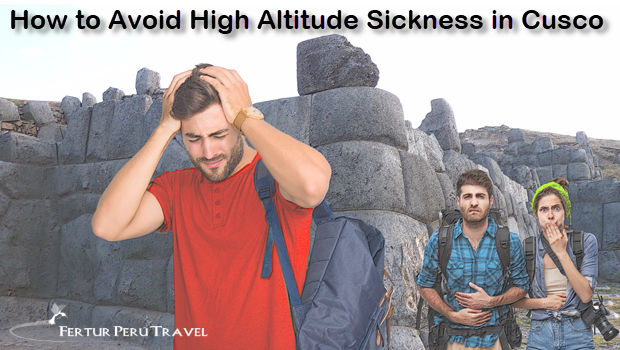
How to prevent altitude sickness in Cusco?
The Inca capital of Cusco, with an altitude of 11,152 feet (3399 meters) above sea level. That is more than two miles high. For an unlucky few the lack of oxygen can trigger high-altitude sickness. Being informed can show you how to avoid altitude sickness in Cusco, prevent feeling sick and possibly save your vacation.
Table of Contents
- What is High Altitude Sickness?
- High altitude sickness symptoms
- What is the altitude in Cusco, Rainbow Mountain, the Sacred Valley and Machu Picchu?
- The Do’s and Don’ts for Soroche
- Bring a Pulse Oximeter
- Deep Breathing Exercises to Ward Off Altitude Sickness
- Hypoxic Training
- Oxygen Supplementation in your Cusco Hotel
- Prescription and Non-prescription Remedies
- Bring Ibuprofen for your Cusco trip
- Check with a doctor about Diamox before your Cusco vacation
- Over-the-counter Acetazolamide (generic Diamox)
- Sorojchi High Altitude Pills (over-the-counter remedy)
- ALTI Vital (over-the-counter remedy)
- Chlorophyll Liquid Drops to Absorb More Oxygen into the Blood
- Other Natural Remedies
- Tips for Traveling to the Sacred Valley
- Other Tips for Traveling to Cusco
- Weather and Wear
- Tips for the tour of Machu Picchu
- Other Cusco Altitude FAQs
- Prepare your trip to Cusco with Fertur Travel
- Would you like more information?
What is High Altitude Sickness?
Rapid ascent to heights exceeding 7,874 feet (2399 meters) above sea level can cause oxygen saturation of hemoglobin in the body to decrease. Most people will feel the effects in Cusco within moments of stepping off the plane from Lima.
Breathing and heart rate increase immediately, and the heart beats faster.
What’s happening is that there are fewer oxygen molecules per lung-full of air. In other words, a smaller percentage of hemoglobin is saturated with brain-nourishing oxygen.
High altitude sickness symptoms
For most people, quicker breathing and the thumping in their chest is the worst of it, as their bodies adapt and the concentration of red blood cells increase.
For others, however, the altitude triggers the oxygen saturation of hemoglobin to plunge. A feeling of breathlessness soon spirals into a prolonged bout of pounding headache, nausea and vertigo.
Scientifically known as hypoxia, acute mountain sickness or “soroche“ are more common names for this condition.
A recent study found that more than a third of travelers to Cusco experience symptoms of altitude sickness, with a significant proportion of cases being moderate-to-severe. This particular Cusco high altitude study reported a 37% incidence rate, which is actually lower than the whopping 49% reported in previous studies. The researchers attribute the difference to changes in the diagnostic criteria used.
“Younger age” travelers, and in particular younger females, were independently associated with a higher risk of acute mountain sickness, according to the study.
What is the altitude in Cusco, Rainbow Mountain, the Sacred Valley and Machu Picchu?
- Cusco Elevation: 3,399 meters / 11,152 feet above sea level
- Vinicunca: 5,200 meters / 17,060 feet above sea level
- Sacred Valley of the Inca
- Pisac: 2,980 meters / 9,776 feet above sea level.
- Calca: 2,929 meters / 9,609 feet above sea level.
- Urubamba: 2,870 meters / 9,416 feet above sea level.
- Ollantaytambo: 2,850 meters / 9,350 feet above sea level.
- Machu Picchu Sanctuary
- Machu Picchu Citadel: 2,430 meters / 7,972 feet above sea level.
- Huayna Picchu: 2,692 meters / 8,835 feet above sea level.
- Machu Picchu Mountain: 3,082 meters / 10,111 feet above sea level.
Understanding the Cusco altitude and the altitudes of nearby attractions can help you better prepare for your trip and prevent altitude sickness.
There are things you can and should do that can help abate, or altogether prevent altitude sickness in Cusco, so you can enjoy these amazing high-altitude destinations.
The Do’s and Don’ts for Soroche
Here are best high altitude tips on how to avoid altitude sickness.
- Do take it very slow and easy. Over exertion can trigger altitude sickness.
- Do drink copious amounts of bottled water or herbal tea. Adjusting to high altitude can lead to dehydration and that in turn can aggravate symptoms.
- Do help yourself to Mate de Coca known as Infusión de Coca, a traditional brew made from coca leaves, a mild stimulant, to help with hydration. It is offered free in the lobby of nearly every hotel in Cusco.
- Don’t drink coca tea if you are subject to drug testing at work. It can result in a false-positive urine drug screen for cocaine.
- Don’t eat heavy meals, which will tax your metabolism, or drink alcohol, which can dehydrate your system. Wait a day or two. The pollo a la brasa and pisco sours will still be there once you’ve acclimatized.
- Do seek an oxygen tank, available in most hotels and even sold over the counter, to relieve extreme symptoms. (Note: Fertur clients can contact their local travel representative, who will be available 24-hours-a-day to offer assistance.)
- Do travel to lower altitude if you’re suffering acute soroche. The full-proof cure-all for soroche is rapid descent. Pisac, the first town you reach in the Sacred Valley, is just a little more than an hour from Cusco, and is more than 1,400 feet lower than the city. Ollantaytambo is closer to 2,000 feet lower. If you’re in the grips of altitude sickness or feel it coming on, going to these lower elevations can provide some quick relief.
Bring a Pulse Oximeter
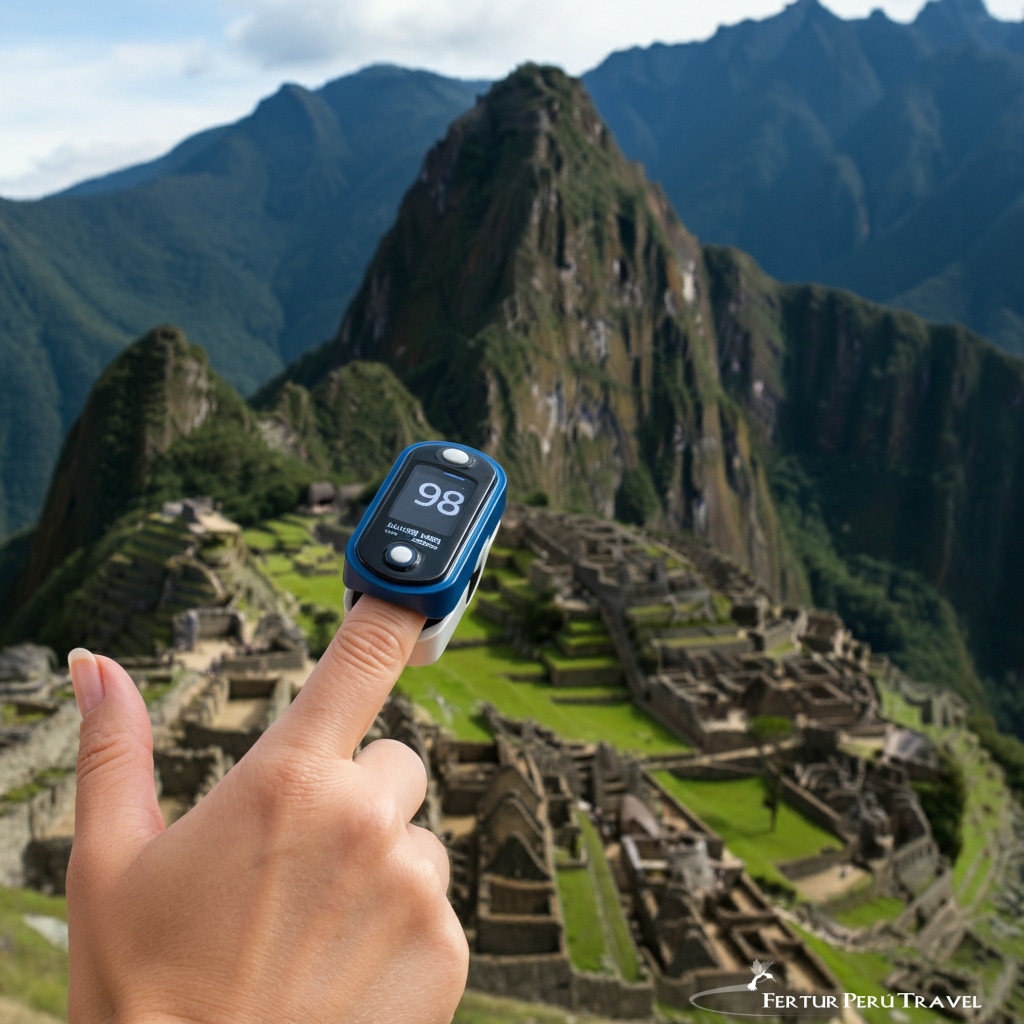
Bring a Pulse Oximeter with you to measure your body’s oxygen levels. The oxygen saturation level of your blood will very likely decrease during the first few hours in Cusco. A drop in blood can persist for the first 12-24 hours as you acclimatize. Some key things to note:
- Oxygen saturation below 90% is considered low. Between 60-79% is considered mild hypoxemia.
- If your oxygen saturation continues trending toward 60% or lower, that’s considered a more severe decrease and raises concerns about acute altitude sickness. Prompt descent or supplemental oxygen would be recommended.
- After a day or two in Cusco, your oxygen saturation should improve and stabilize in the low 90% range as your body acclimatizes to the elevation.
You can get a pulse oximeter at most drug stores, or purchase one very cheaply online. They are a very good idea to monitor your oxygen saturation when you first arrive in Cusco to watch for any concerning drops.
Deep Breathing Exercises to Ward Off Altitude Sickness
Do consider employing any number of slow, deep breathing techniques while seated in a relaxed position. That can help tremendously. Meditation Apps on your Smartphone can be helpful.
Take slow deep breaths in through your nose and exhale through your nose or mouth, depending on the method, being mindful to use four to six counts while inhaling and four to eight counts to exhale.
Hypoxic Training
Do consider preparing with special training before your arrival, especially if you plan to trek one of the higher altitude routes, like Salkantay — a popular alternative to the Inca Trail. Hypoxic training involves simulating high altitude conditions to improve your body’s ability to function with reduced oxygen levels. This type of training can be beneficial for travelers planning physically demanding activities, such as hiking or trekking, in high altitude areas. Hypoxic training can be done using specialized masks or through inspiratory muscle training exercises to strengthen your respiratory muscles.
The Wim Hof Method, popularized by extreme athlete Wim Hof, involves controlled hyperventilation breathing exercises that have been shown to reduce symptoms of altitude sickness. This technique includes taking 30 deep breaths followed by a long breath hold. Research has demonstrated the potential benefits of this technique in reducing the incidence of acute mountain sickness during high altitude treks. However, it’s important to practice this method under proper guidance and consult with your healthcare provider to ensure its suitability for you.
Oxygen Supplementation in your Cusco Hotel
Do inquire about oxygen piped into your room. Several of the 4-star and 5-star hotels in Cusco offer oxygen-enriched rooms. Some hotels that provide oxygen enrichment include:
- Aranwa Cusco Boutique Hotel
- Casa Andina Premium Cusco
- Casa Cartagena
- El Monasterio
- Inkaterra La Casona
- Novotel Cusco
- Palacio del Inka Cusco
- Ramada by Wyndham Costa Del Sol Cusco
However, it’s important to note that oxygen supplementation may delay your body’s natural acclimatization process. If you plan to visit higher altitude destinations after Cusco, an oxygen-enriched room may not be ideal.
If you are still wondering which hotel to stay at in Cusco, then the above options are perfect as you enjoy a luxury experience whilst exploring the highlights of the city and surrounding region. We include these stays in our custom tours around Cusco and Peru, so be sure to take a look and check our availability now!
Prescription and Non-prescription Remedies
Here are some of the best medicinal treatments and herbal remedies for treating the symptoms of altitude sickness or to prevent it altogether.
Bring Ibuprofen for your Cusco trip
Do consider taking ibuprofen (Advil, Motrin, Nuprin, etc.) to prevent or diminish the ill effects of altitude. A 2012 Stanford University study found the drug significantly reduced the incidence of altitude sickness when taken six hours before ascent. The researchers also noted in their double-blind, placebo controlled study that even when the anti-inflammatory didn’t entirely prevent soroche, symptoms were less severe overall for those who took the medicine.
A prescription dose of 600 mg of ibuprofen can “provide more robust prevention,” according to the authors of the Stanford study. But be doubly sure to drink lots of fluids. Ibuprofen can cause gastrointestinal, and even kidney problems, for people when they are dehydrated.
Check with a doctor about Diamox before your Cusco vacation

Do consult with your physician before your trip to Peru about whether you should come prepared with a prescription of acetazolamide (Diamox). It is a proven altitude sickness medication. Taking prophylactic doses of 125 mg twice daily, starting a full day before you travel to high altitude, will help you to metabolize the thinner air.
Over-the-counter Acetazolamide (generic Diamox)
Acetazolamide is also available over the counter in Peru for less than US$3 for 10 pills. (Be sure to choose one of Peru’s major chain pharmacies — Inkafarma, Pharmax, Boticas Arcangel, etc. — and not a Ma and Pop drug store, where adulterated or fake pharmaceuticals are often sold.)
A study published by the Journal of Applied Physiology found that acetazolamide does not reduce or alter endurance or exercise performance at high altitudes — so no worries if you’re planning on tackling Dead Woman’s Pass, the highest point on the Inca Trail.
However, it is important to note that acetazolamide has some minor side effects, such as making your fingers, toes and cheeks tingle. It also makes carbonated drinks taste bitter and metallic.
Diamox and Sulfa Drug Allergy Concerns, etc.
Acetazolamide is definitely not for everyone, including those allergic to sulfa drugs — another reason to first consult your doctor before taking it.
You Might Also Like: Explore The Sacred Valley of the Incas on Private Tour
Sorojchi High Altitude Pills (over-the-counter remedy)
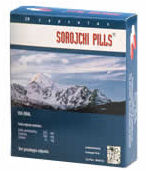
Do consider Sorojchi High Altitude Pills, a Bolivian-made, over-the-counter remedy, containing 325 mg of aspirin, 160 mg of acetaminosalol (Salophen) and 15 mg of caffeine. For many people, a Sorojchi Pill every eight hours, particularly in combination with 400 mg of ibuprofen, can help ward off the worst symptoms of altitude sickness.
ALTI Vital (over-the-counter remedy)
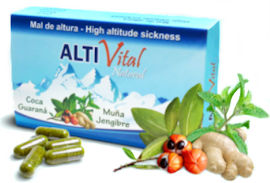
Do consider trying ALTI Vital, a fairly new Peruvian-made alternative remedy to prevent and treat altitude sickness. It is produced using natural ingredients, including coca leaf, ginger, a medicinal jungle fruit called guaraná and minthostachys mollis, an Andean medicinal plant more commonly known as muña, as well as 12.5 mg of caffeine. ALTI Vital can be purchased at any of the many Inkafarma or Mifarma pharmacies around Cusco.
Chlorophyll Liquid Drops to Absorb More Oxygen into the Blood
Do consider liquid chlorophyll. Sold in health food stores in Cusco, a few of these shamrock green drops in a tall glass of water are said to increase production of red blood cells, which in turn can increase the body’s ability to absorb oxygen and facilitate high altitude acclimatization.
Other Natural Remedies
Other natural remedies, such as Ginkgo Biloba extract, are believed to help alleviate the symptoms of altitude sickness. While scientific evidence may be limited, some travelers have reported positive experiences with these remedies. It’s essential to consult with your healthcare provider before trying any natural remedies to ensure they are safe for you and won’t interact with any medications you may be taking.
You Might Also Like: The 3 Best Cusco Private Tours
Tips for Traveling to the Sacred Valley
Do consider spending your first few days in the Sacred Valley, which is significantly lower than Cusco’s altitude, for a smoother acclimatization. Save the city of Cusco for later in the trip when you are fully acclimatized to avoid altitude sickness in Cusco. The valley is warm and generally sunny during the dry season and cool with intermittent rain showers and sun during the rainy season.
You Might Also Like: 4-Day Classic Machu Picchu Travel Package
Other Tips for Traveling to Cusco
Weather and Wear
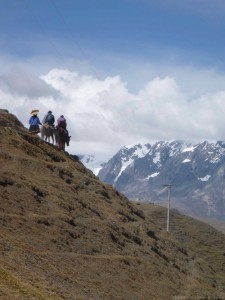
Being prepared for the weather is one of the most important Cusco travel tips. The region experiences two distinct seasons: the dry season and the rainy season. The dry season lasts from May to August, characterized by hot mornings with temperatures soaring high. However, the shade offers respite from the scorching heat during this time. As night falls, the temperature drops significantly, becoming very cold, often accompanied by frost. In contrast, the rainy season, spanning from September to April, brings cool to frigid temperatures and abundant precipitation. The landscape transforms during this period, with the rain nourishing the earth and giving rise to lush vegetation.
Wet or dry, rain or shine, when planning your trip to Cusco, it’s essential to keep the high altitude in mind. The Cusco altitude can be challenging for some travelers, so it’s important to be prepared.
You Might Also Like: The Ultimate 3 Days in Cusco Itinerary
Tips for the tour of Machu Picchu
Machu Picchu altitude: of 7,972 feet (2,430 meters) above sea level. It’s location in the high Amazon jungle of the Cusco department means you should be prepared for warm, sunny and intermittent rainy conditions from May to August, and muggy, overcast and rainy weather from September until April.
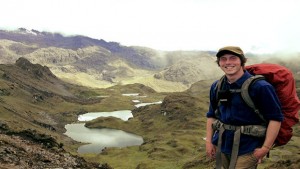
It’s recommended during the dry season to bring along light clothing, sunscreen, and a hat for the warm days, and a warm sweater and jacket for the nights. Also a lightweight rain poncho is a good idea for the occasional showers at Machu Picchu. For the rainy season, you should bring a water-proof jacket and/or lightweight rain poncho and comfortable, breathable cotton clothing to wear in layers as needed.
Other Cusco Altitude FAQs
How do I not get sick in Cusco?
To avoid getting sick in Cusco, take it slow and easy upon arrival, drink plenty of bottled water or herbal tea to stay hydrated, and avoid heavy meals and alcohol for the first couple of days. Consider drinking Mate de Coca, a traditional brew made from coca leaves, which helps with hydration. If symptoms become severe, seek an oxygen tank available in most hotels or travel to lower altitudes, such as Pisac or Ollantaytambo in the Sacred Valley.
How common is altitude sickness in Cusco?
Altitude sickness is quite common among visitors to Cusco, with over one-third of travelers experiencing at least some symptoms. This condition can affect anyone, regardless of age or fitness level, impacting both highly active individuals and those with a more sedentary lifestyle. Recent studies show a decrease in incidence, from 49% in earlier reports to 37%, due to updated diagnostic criteria that exclude sleep disturbances. Despite this reduction, nearly half of the travelers still experience symptoms, with one in five having their travel plans significantly affected. Proper acclimatization, hydration, and preventive measures can help mitigate the risk. Want more information about the prevalence of altitude sickness in Cusco, Read More!
How long does it take to acclimate to altitude in Cusco?
It typically takes a day or two for your body to acclimate to the altitude in Cusco. During this time, your oxygen saturation levels may decrease but should improve and stabilize in the low 90% range as your body adjusts to the elevation.
Which is higher, Cusco or Machu Picchu?
Cusco is higher than Machu Picchu. Cusco is situated at an altitude of 3,399 meters (11,152 feet) above sea level, while Machu Picchu Citadel is at 2,430 meters (7,972 feet) above sea level.
How do I prepare for high altitude Cusco?
To prepare for the high altitude in Cusco, consider hypoxic training before your arrival, especially if you plan to trek higher altitude routes like Salkantay. Hypoxic training involves simulating high altitude conditions to improve your body’s ability to function with reduced oxygen levels. Additionally, bring a pulse oximeter to monitor your oxygen saturation levels, practice deep breathing exercises, and consult with your physician about medications like acetazolamide (Diamox) or ibuprofen.
How do I prepare for Peru altitude?
Preparing for Peru’s high altitudes involves similar strategies as preparing for Cusco’s altitude. Engage in hypoxic training if planning physically demanding activities, use deep breathing techniques, bring a pulse oximeter, and consider taking medications like acetazolamide (Diamox) or ibuprofen. Stay hydrated, avoid heavy meals and alcohol initially, and use traditional remedies like Mate de Coca to help with acclimatization.
Prepare your trip to Cusco with Fertur Travel
As we have seen above, altitude sickness is highly preventable in most cases and especially so if we follow the tips outlined in this article (such as using altitude sickness medication as well as gradually increasing our altitude in increments).
If you want an unforgettable trip to Cusco and the rest of Peru, consider heading on our custom tours. You can tailor every detail to suit your preferences. Combine Cusco with highlights from Arequipa, Lima, and Nazca, and let our experienced team guide you through every stage of the journey. With careful planning, you can reduce the risk of altitude sickness and focus on enjoying all that Peru has to offer.
Would you like more information?
Just reach out to us through Fertur Peru Travel’s Whatsapp or our Contact Us form.
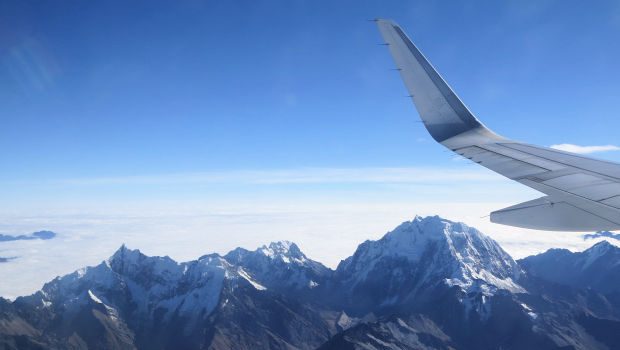 Best airline for stunning ice peak mountain views during flight to Cusco
Best airline for stunning ice peak mountain views during flight to Cusco 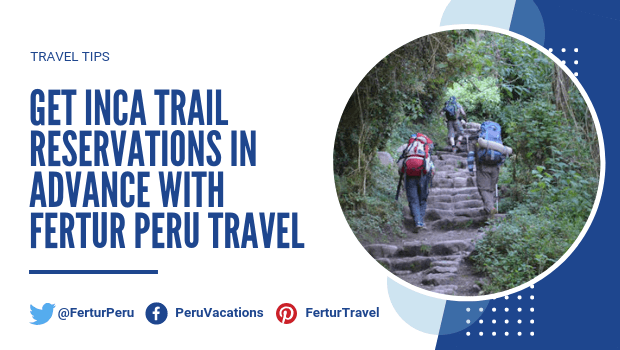 Get Inca Trail Reservations in Advance with Fertur Peru Travel
Get Inca Trail Reservations in Advance with Fertur Peru Travel  What is the best time to visit Peru?
What is the best time to visit Peru?  Sacred Warriors Comics on Sale at Cusco News Stands Now
Sacred Warriors Comics on Sale at Cusco News Stands Now  10 Steps to Cyber Safety During Your Peru Vacation
10 Steps to Cyber Safety During Your Peru Vacation  Peru Will Enforce 6-Month Passport Rule
Peru Will Enforce 6-Month Passport Rule 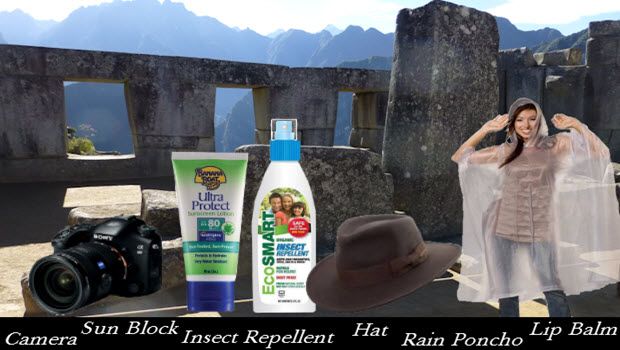 What should I carry in my backpack to go to Machu Picchu?
What should I carry in my backpack to go to Machu Picchu? 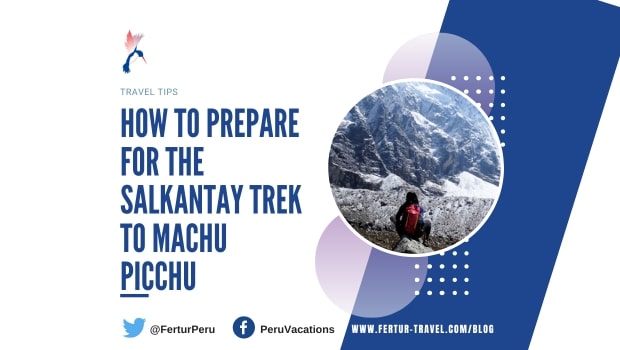 How to Prepare for the Salkantay Trek to Machu Picchu
How to Prepare for the Salkantay Trek to Machu Picchu
What exactly is meant by altitude sickness? I’ve heard about travel sickness and whatnot, but it’s the first I hear about altitude sickness. Can anyone explain this to me, please?
Read the article above for explanation lol